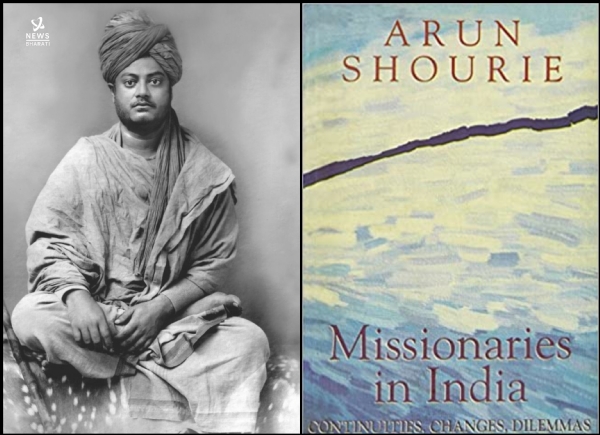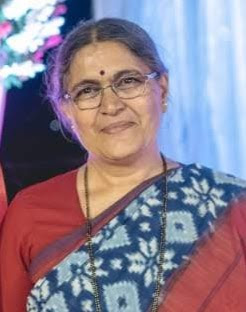INSIGHT III: Swami and Gandhi's views on Christian missionaries through the lens of Arun Shourie's book
The observations made in the 1911 and 1931 censuses are the same. The converts are from lower-class Hindus and aboriginal tribes. (Oraonns,Mundas, Kharias and Santhals) They are perceived as high-yielding ground for conversion, their share was then almost 88 percent.
Total Views |
Namaskar, the new series 'INSIGHT' is an attempt to present the central thought of a thought-provoking book. "Missionaries In India Continuities, Changes, Dilemmas", a book by Shri Arun Shourie compels readers to contemplate various points put forth. It refers to towering personalities like Swami Vivekanand and Mahatma Gandhi. When one reads their views one cannot help thinking that many socially aware people would like to know these facts.
 One Prophet, one Text, one Church- has some consequences. The prophet is treated to be the last word on everything and the text is treated to be a dogma that turns into a dynamic of its own. This situation influences most of the aspects of the life of common people. The Communist movement can be studied as an example of such consequences.
One Prophet, one Text, one Church- has some consequences. The prophet is treated to be the last word on everything and the text is treated to be a dogma that turns into a dynamic of its own. This situation influences most of the aspects of the life of common people. The Communist movement can be studied as an example of such consequences.
The church as an institution developed some order. It becomes more or less like a marketing agency that discusses the strategy as to what should be highlighted and what would be played down.
The concern is expressed in the report of CBCI ( Catholic Bishop Conference of India)which discusses 'Trend in Numerical Conversion '. It stated then that the population of Catholics is nine lakh in Arunachal Pradesh. ( It is still a thinly populated state, the book is first published in 1992. The present population seems to be 17.49 lakhs) Tribals were their target group, the other one is Harijans.
The observations made in the 1911 and 1931 censuses are the same. The converts are from lower-class Hindus and aboriginal tribes. (Oraonns,Mundas, Kharias and Santhals) They are perceived as high-yielding ground for conversion, their share was then almost 88 percent.
There are some cases of 'relapse' also, as they lose the benefits of being a Dalit, sometimes 'fear and pressure' work.
Swami Ji's statements made in the address at Detroit (11 March 1894) may help to understand how closely they corresponded with reality. "As to the way of converting, it is absolutely absurd. The colleges funded by missionaries are alright, so far the education is concerned. But religion is different. "
The background paper prepared for the conference describes how the conversion of 'the oppressed scheduled case has been going on since the 16'th century. These converts got isolated from Hindus and Christians also. And the basic necessities provided to them created dependency, the human dignity and fundamental rights were compromised. It is reported that their discrimination from society and church continued. It resulted in a kind of identity crisis. The Bishop in Madhya Pradesh confirms the fact that the conversions were due to material incentives.
The census report of 1911 has some factors leading to conversions explained.
1) People of tribes had no objection to eating with converts and Christians.
2)The converts could be re-admitted to the original tribe.
3) There always used to be a hope of assistance and protection.
4) The belief that missionaries would stand by them in the land-related disputes and legally advise them in agriculture-related disputes.
5) The belief that missionaries always think of the welfare of their group.
Missionaries to a great extent did not fail them. Their desertions and display of animosity were also observed.
The prospects of benefits determined whether they are staying with the new faith or relapsing.

The church as an institution developed some order. It becomes more or less like a marketing agency that discusses the strategy as to what should be highlighted and what would be played down.
The concern is expressed in the report of CBCI ( Catholic Bishop Conference of India)which discusses 'Trend in Numerical Conversion '. It stated then that the population of Catholics is nine lakh in Arunachal Pradesh. ( It is still a thinly populated state, the book is first published in 1992. The present population seems to be 17.49 lakhs) Tribals were their target group, the other one is Harijans.
Also Read: INSIGHT II: Swami and Gandhi's views on Christian missionaries through the lens of Arun Shourie's book
The observations made in the 1911 and 1931 censuses are the same. The converts are from lower-class Hindus and aboriginal tribes. (Oraonns,Mundas, Kharias and Santhals) They are perceived as high-yielding ground for conversion, their share was then almost 88 percent.
There are some cases of 'relapse' also, as they lose the benefits of being a Dalit, sometimes 'fear and pressure' work.
Swami Ji's statements made in the address at Detroit (11 March 1894) may help to understand how closely they corresponded with reality. "As to the way of converting, it is absolutely absurd. The colleges funded by missionaries are alright, so far the education is concerned. But religion is different. "
The background paper prepared for the conference describes how the conversion of 'the oppressed scheduled case has been going on since the 16'th century. These converts got isolated from Hindus and Christians also. And the basic necessities provided to them created dependency, the human dignity and fundamental rights were compromised. It is reported that their discrimination from society and church continued. It resulted in a kind of identity crisis. The Bishop in Madhya Pradesh confirms the fact that the conversions were due to material incentives.
The census report of 1911 has some factors leading to conversions explained.
1) People of tribes had no objection to eating with converts and Christians.
2)The converts could be re-admitted to the original tribe.
3) There always used to be a hope of assistance and protection.
4) The belief that missionaries would stand by them in the land-related disputes and legally advise them in agriculture-related disputes.
5) The belief that missionaries always think of the welfare of their group.
Missionaries to a great extent did not fail them. Their desertions and display of animosity were also observed.
The prospects of benefits determined whether they are staying with the new faith or relapsing.



